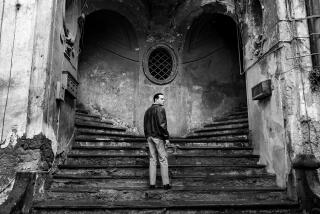Catting Around
- Share via
D r. Seuss’ wily, fast-talking feline in a top hat returns to the big screen this month in a live-action adaptation of the 1957 classic book “The Cat in the Hat.” The job of creating the Seussian world went to British production designer Alex McDowell. He designed a set that includes a surreal neighborhood of very real lilac homes in Simi Valley and a cartoonish Main Street U.S.A. in Pomona. “We wanted it to be recognizable but otherworldly at the same time . . . a parallel universe,” McDowell says. The film’s director, Bo Welch, a production designer of such stylized films as “Beetlejuice,” “Edward Scissorhands” and “Batman Returns,” puts it this way: “On a scale of 1 to 10, where 1 is reality and a 10 is complete fantasy, we started the film at 4.5 and finished at 11.”
First and foremost, for both director and production designer, it’s a movie from a child’s point of view. When a kid conjures up a house, what comes to mind? A peaked roof, a chimney, four windows and a door. The designer translated those basic architectural elements into the structure, then stretched and exaggerated the exterior vertically, making the houses very tall and narrow. Everything inside the Walden family’s home, such as doors, handles, windows and a stair banister, were made large and slightly out of reach, as they might appear if you were a kid.
To put the house in context, McDowell designed a faux-neighborhood of 22 set homes in Simi Valley, seeding and irrigating 13 acres of rolling hills with meadow grass to create a verdant backdrop. In a typical suburban neighborhood, the houses would have been white clapboard surrounded with white picket fences, but in McDowell’s Cat’s world, all the houses and fences are lilac.
In a child’s imagination, color plays a dominant role, of course. To unify the film and bring to life the stylized cosmos, McDowell imposed a medley of greens on every furnishing--from wallpaper and carpets to chairs, sofas and accessories, even flower arrangements. Accents of crayon yellow, lilac, purple and coral play smaller roles. It’s a perfect foil to offset the Cat, played by Mike Myers, whose clothes are red, white and black. “We wanted him to jump off the screen when he arrived,” McDowell says. The only reds are the Cat and his belongings, such as his crate (a.k.a. Trans-Dimensional-Transportolator) and S.L.O.W. (Super Luxurious Omnidirectional Whatchamajigger) car.
Working with set decorator Anne Kuljian, McDowell called in furniture designer/artist Roy McMakin to create some of the film’s furnishings, including his signature “Simple Chair” in which the children sit gazing out of the window after their mother leaves. Known for his unique style of distilling a piece of furniture to its essence by simplifying and over-scaling, McMakin designed chairs, sofas and tables that epitomize the look the filmmakers wanted. Other furniture designed in-house, such as the high-backed dining room chairs and the living room’s formal Lawson sofa, were made with straight shaker lines to complement the artist’s furnishings.
When Seuss’ little boy character, Conrad Walden, unlocks the Cat’s magical red crate, the “normal” house slowly transmutes into a theme-park environment. “It becomes distorted as if you were looking at the house’s image in a fun-house mirror,” McDowell says. The hallway’s striped green-and-yellow wallpaper takes on a wavy, psychedelic appearance. Striped floors and sculpted carpets turn into deep, undulating furrows resembling plowed fields. Streamlined sofas and chairs morph into pretzel-like shapes, and a curved staircase becomes a wild water ride.
To achieve the distorted effects, a model of the transformed house was created in a computer. More than 250 printouts of the 3-D models emerged in four-foot cross sections. The resulting 60-by-80-foot set, carved in foam, covered with resin and painted the same colors as the original house, appears to be made out of taffy. “Everything is pulled and exaggerated,” McDowell says. “There’s not a straight line in the pace.”
More to Read
Only good movies
Get the Indie Focus newsletter, Mark Olsen's weekly guide to the world of cinema.
You may occasionally receive promotional content from the Los Angeles Times.










